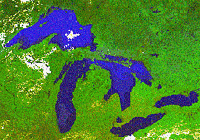
![]()
![]()
![]()
![]()
![]()
![]()
![]()
![]()
![]()
![]()
![]()

Great Lakes Environmental Research Laboratory
The Great Lakes Environmental Research Laboratory (GLERL) carries out research and provides scientific products, expertise, and services required for effective management and protection of Great Lakes and coastal ecosystems. As part of NOAAs mission, GLERL science provides for protection of life and property, economic well-being, and sustained ecosystem health. With a wide array of scientific disciplines on staff, and an ecosystem-level focus, GLERL contributes unique capabilities in support of intelligent and cost-effective Great Lakes and coastal resource management. Key GLERL scientific activities include:
- Identifying sources, pathways, and fate of toxic contaminants as they are cycled through aquatic ecosystems.
- Observing, explaining, and predicting the natural forces driving waves, currents, storm surges, seiches and related physical phenomena.
- Explaining and predicting changes in water resources, lake water levels, and flows.
- Documenting, understanding, and predicting the distribution and extent of ice on the lakes over winter.
- Developing remote sensing programs such as CoastWatch.
- Developing and refining acoustical (sonar-based) methods to locate and study fish populations.
- Producing high-resolution mapping (bathymetry) of lake bottom regions.
- Developing and applying radioisotope techniques to chronicle historical changes in Great Lakes and coastal sediments.
- Supporting and promoting education and training of next-generation Great Lakes scientists.
- Monitoring and describing changes in abundances and structure of plant and animal populations.
- Tracking the spread of invasive (exotic) species and determining their impact on Great Lakes and coastal ecosystem health.
- Observing, describing and understanding the role of episodic events and their impact on lake physical, chemical, and biological processes.
- Collecting and building long-term databases of physical, chemical, and biological information within an integrated monitoring program.
- Providing scientific expertise, advice, reviews, and recommendations to resource managers and decision makers.
- Examining the potential impact of climate and global change on Great Lakes water quantity and quality.
- Investigating nearshore hydrodynamic processes affecting protection of health, life, property, and environmental quality.
- Studying how changes in Great Lakes foodwebs affect nutrient cycling and ecosystem production.
For more information contact:
Great Lakes Environmental Research Laboratory
2205 Commonwealth Blvd
Ann Arbor, MI 48105-2945
734-741-2235
http://www.glerl.noaa.gov
![]()
atmosphere | climate | oceans
organization | education
| newsroom | search | home